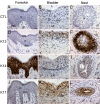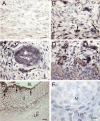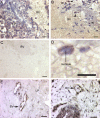Fibroblast growth factor-10 signals development of von Brunn's nests in the exstrophic bladder
- PMID: 20719973
- PMCID: PMC2980411
- DOI: 10.1152/ajprenal.00056.2010
Fibroblast growth factor-10 signals development of von Brunn's nests in the exstrophic bladder
Abstract
von Brunn's nests have long been recognized as precursors of benign lesions of the urinary bladder mucosa. We report here that von Brunn's nests are especially prevalent in the exstrophic bladder, a birth defect that predisposes the patient to formation of bladder cancer. Cells of von Brunn's nest were found to coalesce into a stratified, polarized epithelium which surrounds itself with a capsule-like structure rich in types I, III, and IV collagen. Histocytochemical analysis and keratin profiling demonstrated that nested cells exhibited a phenotype similar, but not identical, to that of urothelial cells of transitional epithelium. Immunostaining and in situ hybridization analysis of exstrophic tissue demonstrated that the FGF-10 receptor is synthesized and retained by cells of von Brunn's nest. In contrast, FGF-10 is synthesized and secreted by mesenchymal fibroblasts via a paracrine pathway that targets basal epithelial cells of von Brunn's nests. Small clusters of 10pRp cells, positive for both FGF-10 and its receptor, were observed both proximal to and inside blood vessels in the lamina propria. The collective evidence points to a mechanism where von Brunn's nests develop under the control of the FGF-10 signal transduction system and suggests that 10pRp cells may be the original source of nested cells.
Figures












Similar articles
-
Management of transitional cell carcinoma involving von Brunn's nests.J Urol. 1995 Mar;153(3 Pt 2):944-9. J Urol. 1995. PMID: 7853580
-
The fine structure of Brunn's nests in human bladder urothelium.J Submicrosc Cytol Pathol. 1990 Apr;22(2):203-10. J Submicrosc Cytol Pathol. 1990. PMID: 2337887
-
[Histologic and autoradiographic studies on the significance and terminology of von Brunn's nests in biopsies of the bladder mucosa].Zentralbl Allg Pathol. 1984;129(2):119-25. Zentralbl Allg Pathol. 1984. PMID: 6730748 German.
-
The pathology of urinary bladder lesions with an inverted growth pattern.Chin J Cancer Res. 2016 Feb;28(1):107-21. doi: 10.3978/j.issn.1000-9604.2016.02.01. Chin J Cancer Res. 2016. PMID: 27041933 Free PMC article. Review.
-
[An unusual variant of urothelial carcinoma: the "nested variant of urothelial carcinoma." Report of two cases].Ann Pathol. 1999 Apr;19(2):119-23. Ann Pathol. 1999. PMID: 10349476 Review. French.
Cited by
-
Fgfr2 is integral for bladder mesenchyme patterning and function.Am J Physiol Renal Physiol. 2017 Apr 1;312(4):F607-F618. doi: 10.1152/ajprenal.00463.2016. Epub 2017 Jan 4. Am J Physiol Renal Physiol. 2017. PMID: 28052872 Free PMC article.
-
Anterior pelvic exenteration for exstrophic bladder adenocarcinoma: Case report and review.Int J Surg Case Rep. 2016;25:13-5. doi: 10.1016/j.ijscr.2016.05.022. Epub 2016 Jun 1. Int J Surg Case Rep. 2016. PMID: 27288750 Free PMC article.
-
Fgfr2 is integral for bladder mesenchyme patterning and function.Am J Physiol Renal Physiol. 2015 Apr 15;308(8):F888-98. doi: 10.1152/ajprenal.00624.2014. Epub 2015 Feb 4. Am J Physiol Renal Physiol. 2015. Retraction in: Am J Physiol Renal Physiol. 2016 Jul 1;311(1):F239. doi: 10.1152/ajprenal.zh2-7964-retr.2016. PMID: 25656370 Free PMC article. Retracted.
-
Tissue engineering in pediatric urology - a critical appraisal.Innov Surg Sci. 2018 May 25;3(2):107-118. doi: 10.1515/iss-2018-0011. eCollection 2018 Jun. Innov Surg Sci. 2018. PMID: 31579774 Free PMC article. Review.
-
von Brünn Nests Hyperplasia as a Cause of Ureteral Stenosis After Kidney Transplantation.Kidney Int Rep. 2016 Nov 30;2(3):498-501. doi: 10.1016/j.ekir.2016.11.008. eCollection 2017 May. Kidney Int Rep. 2016. PMID: 29142977 Free PMC article. No abstract available.
References
-
- Al Ahmadie H, Gomez AM, Trane N, Bove KE. Giant botryoid fibroepithelial polyp of bladder with myofibroblastic stroma and cystitis cystica et glandularis. Pediatr Dev Pathol 6: 179–181, 2003 - PubMed
-
- Bagai S, Rubio E, Cheng JF, Sweet R, Thomas R, Fuchs E, Grady R, Mitchell M, Bassuk JA. Fibroblast growth factor-10 is a mitogen for urothelial cells. J Biol Chem 277: 23828–23837, 2002 - PubMed
-
- Bassuk JA, Birkebak T, Rothmier JD, Clark JM, Bradshaw A, Muchowski PJ, Howe CC, Clark JI, Sage EH. Disruption of the Sparc locus in mice alters the differentiation of lenticular epithelial cells and leads to cataract formation. Exp Eye Res 68: 321–331, 1999 - PubMed
-
- Bassuk JA, Grady R, Mitchell M. The molecular era of bladder research. Transgenic mice as experimental tools in the study of outlet obstruction. J Urol 164: 170–179, 2000 - PubMed
-
- Beare JB, Tormey AR, Jr, Wattenberg CA. Exstrophy of the urinary bladder complicated by adenocarcinoma. J Urol 76: 583–594, 1956 - PubMed
Publication types
MeSH terms
Substances
Grants and funding
LinkOut - more resources
Full Text Sources

